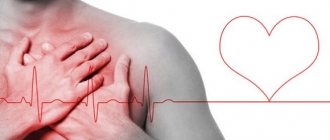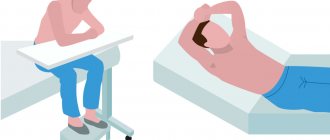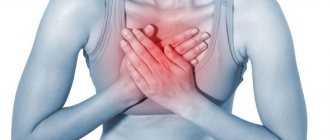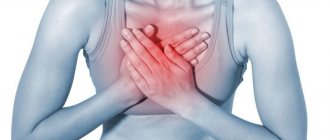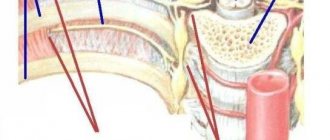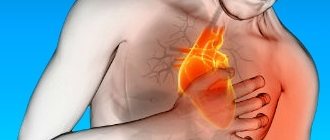Chest pain
(chest pain) is a common symptom. In many cases, chest pain can be caused by heart disease, and this makes it especially serious. However, the list of causes of chest pain is much wider. This area contains the heart, lungs, esophagus, large vessels, bones and muscles - and any of these organs can be a source of pain. Chest pain can also be caused by the diaphragm and abdominal organs, primarily the stomach. Finally, pain can be caused by problems in other organs, and its localization in the chest is explained by the complex arrangement of nerves and muscles.
Possible nature of chest pain - what you should pay attention to
Chest pain can be aching, stabbing, shooting, squeezing, burning. In some cases it can be acute, intense, even intolerable.
It is important where exactly the pain is localized. Usually the pain can be quite clearly localized as follows:
- in one half of the chest - right or left. Sometimes the localization of pain can be more specific, for example, in the ribs;
- behind the sternum. Pain behind the sternum, especially when it hurts both behind the sternum and to the left of it, is characteristic of heart disease;
- just below the sternum (in the epigastric region). Such pain is typical for diseases of the digestive tract (stomach or esophagus).
Chest pain without a clear localization may indicate lung cancer or tuberculosis.
Chest pain may be accompanied by symptoms such as:
- shortness of breath, difficulty breathing;
- cough, increased body temperature;
- weakness, cold sweat;
- belching, heartburn, nausea, vomiting;
- changes in blood pressure.
The distribution of pain is also important for diagnosis. The pain may radiate to the arm. This type of pain is observed with myocardial infarction and osteochondrosis.
Diagnostics
The first thing the doctor will do is interview and examine the patient, which will allow him to narrow the search for pathology based on associated symptoms. After this, various diagnostic procedures may be prescribed to determine the cause of the pain. Magnetic resonance imaging may be helpful
or
computed tomography
,
x-ray
, ultrasound, blood tests, etc. This will determine why pain occurs in the middle of the chest, which radiates to the back, upper limbs or ribs.
Causes
Chest pain due to heart disease
Chest pain is a characteristic symptom of heart disease. It is observed, in particular, when:
- coronary heart disease (caused by insufficient oxygen supply to the heart muscle). The most common form of coronary artery disease is angina pectoris, which manifests itself in the form of discomfort, a feeling of heaviness or compressive pain behind the sternum and to the left of it. An attack of pain is usually provoked by physical activity or emotional stress. The duration of the attack usually ranges from several minutes to half an hour. Relief occurs after taking nitroglycerin. The pain may be accompanied by shortness of breath, radiating to the left arm, under the shoulder blade, and the left half of the lower jaw;
- acute myocardial infarction. Myocardial infarction is also a form of coronary heart disease that requires immediate medical attention. The pain during myocardial infarction is very intense and has a compressive, pressing or bursting character. It is observed behind the sternum and to the left of it, and can radiate to the left arm, under the shoulder blade, to the left side of the neck and lower jaw. The pain is accompanied by shortness of breath, fear of death, weakness, and cold sweat may appear. The pain lasts more than 15-30 minutes (i.e. longer than during an attack of angina) and is not relieved by nitroglycerin. If you suspect a myocardial infarction, you should immediately call an ambulance;
- pericarditis (inflammation of the outer lining of the heart - the pericardium). In this case, the pain may be constant or intermittent. It is usually localized behind the sternum. The pain increases when lying down, and decreases if you lean forward;
- myocarditis (inflammation of the heart muscle). Myocarditis occurs most often as a complication of an infectious disease. With myocarditis, chest pain is combined with fever and shortness of breath;
- mitral valve prolapse. In most cases, this disease is asymptomatic, but sometimes there is pain in the left side of the chest, which may be accompanied by a feeling of shortness of breath, a feeling of rapid or slow heartbeat, dizziness and fainting.
Chest pain due to respiratory diseases
Chest pain can occur with diseases such as:
- pleurisy (inflammation of the membrane of the lung - pleura). In case of pleurisy, the pain is usually acute and one-sided. Intensifies with deep breaths, laughter, and movement. The pain intensifies when bending to the healthy side. The pain decreases if you lie on the side where it hurts. Chest pain is combined with other symptoms - fever, chills, weakness, cough;
- pneumonia (pneumonia). Chest pain with pneumonia is a concomitant symptom that occurs against a background of cough and fever. The pain is usually one-sided - corresponds to the side on which inflammation develops. The nature of the pain is sharp or aching;
- bronchitis;
- tracheitis;
- pulmonary tuberculosis;
- lungs' cancer.
Chest pain due to diseases of the digestive tract
Pain in the chest area can be caused by diseases such as:
- stomach ulcer. With a stomach ulcer, the pain is usually described as “burning.” It is localized in the epigastric region and can radiate to the left half of the chest. Occurs after eating;
- gastroesophageal reflux disease (reflux of stomach contents back into the esophagus). Acidic or alkaline contents irritate the lining of the esophagus, causing bloating and severe pain in the epigastric region and the left side of the chest. An attack can be triggered by eating too much at night, strong coffee, or alcohol abuse. In addition to chest pain, heartburn and belching may occur;
- hiatal hernia. In most cases, the disease is asymptomatic. In some cases, aching or burning pain behind the sternum and in the epigastric region may be observed. Pain usually occurs after eating in a horizontal position. May be accompanied by hiccups, heartburn, belching, and sometimes vomiting (in obese women).
Other Possible Causes of Chest Pain
Chest pain can also be caused by:
- osteochondrosis of the cervical and thoracic spine. Pain with osteochondrosis can be similar to an angina attack and can radiate to the shoulder blade, arm, or shoulder. Sometimes there is numbness in the hand. Another option for pain with osteochondrosis is lumbago. It is provoked by turns of the body, movement of the arms, prolonged exposure to a lying position (during night sleep);
- intercostal neuralgia. In this case, the pain is usually limited to one intercostal space. The nature of the pain is “shooting”;
- shingles. The disease is caused by one of the varieties of the herpes virus. The pain is intense, burning. After 7-10 days, blistering rashes appear along the affected nerves;
- vegetative-vascular dystonia.
Our specialists
Tarasova Svetlana Vitalievna
Expert No. 1 in the treatment of headaches and migraines. Head of the Center for the Treatment of Pain and Multiple Sclerosis.
Somnologist.
Epileptologist. Botulinum therapist. The doctor is a neurologist of the highest category. Physiotherapist. Doctor of Medical Sciences.
Experience: 23 years.Derevianko Leonid Sergeevich
Head of the Center for Diagnostics and Treatment of Sleep Disorders.
The doctor is a neurologist of the highest category. Vertebrologist. Somnologist. Epileptologist. Botulinum therapist. Physiotherapist. Experience: 23 years.
Palagin Maxim Anatolievich
The doctor is a neurologist. Somnologist. Epileptologist. Botulinum therapist. Physiotherapist. Experience: 6 years.
Zhuravleva Nadezhda Vladimirovna
Head of the center for diagnosis and treatment of myasthenia gravis.
The doctor is a neurologist of the highest category. Physiotherapist. Experience: 16 years.
Mizonov Sergey Vladimirovich
The doctor is a neurologist. Chiropractor. Osteopath. Physiotherapist. Experience: 8 years.
Bezgina Elena Vladimirovna
The doctor is a neurologist of the highest category. Botulinum therapist. Physiotherapist. Experience: 24 years.
Drozdova Lyubov Vladimirovna
The doctor is a neurologist. Vertebroneurologist. Ozone therapist. Physiotherapist. Experience: 17 years.
Dyachenko Ksenia Vasilievna
Head of the center for the treatment of dizziness and balance disorders.
The doctor is a neurologist of the highest category.
Angioneurologist. Neurorehabilitation specialist. Physiotherapist. Candidate of Medical Sciences.
Experience: 19 years.Volkova Svetlana Anatolevna
Head of the Center for Parkinsonism and Extrapyramidal Diseases.
The doctor is a neurologist of the highest category. Epileptologist. Ozone therapist. Physiotherapist. Experience: 26 years.
Which doctor should I contact for chest pain?
If you have chest pain, you should first consult a general practitioner - family doctor or therapist. It is he (and not the patient himself) who should draw up the examination plan. Your GP can refer you to:
- to a cardiologist - if there is reason to believe that the pain is caused by heart disease (localized behind the sternum and to the left of it, relieved with nitroglycerin, accompanied by shortness of breath, etc.);
- see a pulmonologist if you suspect pneumonia or pleurisy (if pain is accompanied by cough and fever);
- to a gastroenterologist - if you suspect diseases of the esophagus and stomach (if the pain is accompanied by belching, heartburn, or occurs after eating);
- see a neurologist in case of “shooting” pain.
Treatment
Treatment is selected depending on the diagnosis and may include both outpatient medication and hospitalization with surgery. The patient can also be prescribed and selected diet, physical activity and other measures for recovery, rehabilitation and reduction of symptoms and pain relief. The timing and number of treatment methods used are individual. If you have pain in the chest and back, go to the doctor. If you consult a neurologist
the problem can be solved either completely or the risk of complications and further health problems can be significantly reduced.
What tests may be needed for chest pain?
If you complain of chest pain, the following may be prescribed to diagnose the disease:
- chest x-ray;
- computed tomography (MSCT chest);
- ECG;
- Holter monitoring (24-hour ECG monitoring);
- general blood test (allows you to determine the presence of inflammation);
- gastroscopy (if diseases of the esophagus or stomach are suspected).
stress tests (treadmill test);
Intercostal neuralgia
With this diagnosis, a person experiences severe pain when being in an uncomfortable position, making sudden movements, sneezing, coughing, or simply inhaling and exhaling. The pain, once it begins, persists for a long time and practically does not go away completely, only subsiding slightly. An attack can occur both during the day and at night, even during sleep.
Intercostal neuralgia
Important. This pathology mainly affects older and elderly people; children do not suffer from intercostal neuralgia.
The pathology is related cause-and-effect to thoraco-dorsal osteochondrosis and intervertebral hernia.
Spine or heart
This disease is quite difficult to differentiate from angina pectoris. In any case, most patients mistake discomfort in the intercostal space for heart pain.
There are a number of differences between it and angina that you need to know.
- In case of cardiac pathologies, pain begins and continues during the load while it is being carried out. If you take a calm position, it hurts less. Neuralgia maintains pain even at rest.
- There are several pain points for neuralgic pain, and they can be easily felt from the back. Angina pectoris causes girdling pain in the dorso-thoracic area, which is diffuse in nature.
- Relief of angina pain occurs at rest and only neuralgic pain can be weakened by changing position.
Symptoms of an angina attack
If you want to learn in more detail how to treat osteochondrosis of the cervicothoracic region, as well as consider the symptoms and manifestations, you can read an article about this on our portal.
Treatment
The following methods are used to relieve neuralgic pain: therapy, blockade, surgery.
Vertebral thoracic osteochondrosis or hernia
As you can see, pain in this area is not always associated with degenerative changes in the spine. But two problems with the spine directly lead to pain in the back area opposite the chest.
One of them is thoracic osteochondrosis. The second is a hernia. With these diseases of the intervertebral discs, pain in the area of the thoracic vertebrae is the main symptom. The occurrence of pain is explained by complex processes of a biological and chemical nature, as a result of which the fibrous ring is subjected to some type of destruction.
With osteochondrosis, the intervertebral foramina narrow, squeezing blood vessels and nerves, and growths of bone tissue—osteophytes—appear along the edges of the vertebrae.
This is the most common pathology among other disorders of the musculoskeletal system.
Intervertebral hernia
Three types of herniated disc
Despite their static location, the thoracic vertebrae are subject to serious stress. Due to their accumulation and age-related changes, metabolic transformations begin in articular cartilage. They weaken their strength, become thinner and lose their elasticity. The more changes the segments undergo, the more intense the pain the patient experiences.
Scoliotic deformities
All diseases that result in poor posture cause pain in the thoracic spinal area. This can be observed in young people, with osteoarthritis or Scheuermann-Mau disease, as well as with kyphosis, kyphoscoliosis and any form of scoliosis.
Scheuermann-Mau disease: general information
Scheuermann-Mau, kyphosis
Prices for orthopedic corsets and posture correctors
The pathology begins in the joints connecting the ribs. Their tissues become coarser, lose elasticity, and weaken their connective functions. Potassium salts are deposited on the vertebral bone, forming an osteophyte. This growth begins to pinch the nerve, compressing the intervertebral canal. A pain syndrome develops - from mild to unbearable, localized in the interscapular area.
Injuries
Varying degrees of spinal injury can cause varying degrees of pain in the thoracic vertebral area.
Spinal injury
This category includes all mechanical impacts - dislocations, bruises, concussions, fractures, impacts, displacements. They can cause damage to the spinal canal, which will ultimately lead to complete paralysis. The most serious injury is a fracture.
Compression type fractures
In case of injury, the symptoms depend on the nature of the damage, but in any case, coughing and sneezing will be painful, breathing may be difficult due to pain, and sudden movements will become impossible.
While palpating the pain points, the reaction will intensify. If injured, a bruise or swelling will be visible. Partial limitation of mobility may occur.
By the way. If the fracture occurs without damage to the spinal canal, the patient will experience pain when bending sideways, as well as the inability to raise straight legs. There will be bruising and swelling at the fracture site.
In old age, when osteoporosis occurs, the vertebral body may break due to its fragility. In this situation, inhaling and exhaling, any sideways movement, lifting even a slight weight and coughing will cause pain in the sternum, under the shoulder blade or between the shoulder blades.

